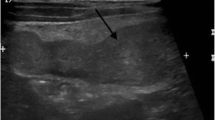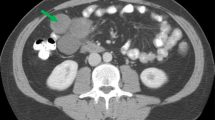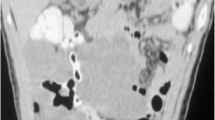Abstract
Omental mesenteric myxoid hamartoma (OMH) is a distinctive myxoid lesion of infancy, characterized by a benign clinical behavior. In the current World Health Organization (WHO) classification of soft tissue tumors, it is considered as part of the morphologic spectrum of inflammatory myofibroblastic tumors (IMT), but this relationship with IMT is still subject to debate. Four lesions with histologic features of OMH occurring in newborns and toddlers are described and compared with classic, ALK-positive IMT. All OMH showed a peculiar dot-like immunostaining for ALK, which, in one of the cases, was cytogenetically found to be associated with an inversion of the ALK gene. While OMHs were positive for smooth muscle actin (SMA), desmin, WT1, podoplanin, and cytokeratins (CAM5.2 and AE1-3), IMT were consistently positive only for SMA (10 cases). ALK-1 displayed cytoplasmic staining in IMT and characteristic paranuclear dot-like staining in OMH.




Similar content being viewed by others
References
Gonzales-Crussi F, deMello DE, Sotelo-Avila C (1983) Omental-mesenteric myxoid hamartomas. Infantile lesions simulating malignant tumors. Am J Surg Pathol 7:567–578
Fletcher CDM, Bridge JA, Hogendoorn PCW, Mertens F (eds) (2013) WHO classification of tumours of soft tissue and bone. IARC, Lyon
Coffin CM, Watterson J, Pries JR, Dehner LP (1995) Extrapulmonary inflammatory myofibroblastic tumor (inflammatory pseudotumor). A clinicopathologic and immunohistochemical study of 84 cases. Am J Surg Pathol 19:859–872
Coffin CM, Hornick JL, Fletcher CD (2007) Inflammatory myofibroblastic tumor: comparison of clinicopathologic, histologic, and immunohistochemical features including ALK expression in atypical and aggressive cases. Am J Surg Pathol 31(4):509–520
Coffin CM, Patel A, Perkins S, Elenitoba-Johnson KS, Perlman E, Griffin CA (2001) AKL1 and p80 expression and chromosomal rearrangements involving 2p23 and inflammatory myofibroblastic tumor. Mod Pathol 14:569–576
Alaggio R, Cecchetto G, Bisogno G, Gambini C, Calabrò ML et al (2010) Inflammatory myofibroblastic tumors in childhood: a report from the Italian Cooperative Group studies. Cancer 116(1):216–226
Lawrence B, Perez-Atayde A, Hibbard MK, Rubin BP, Dal Cin P, Pinkus JL et al (2000) TPM3-ALK and TPM4-ALK oncogenes in inflammatory myofibroblastic tumors. Am J Pathol 157(2):377–384
Cools J, Wlodarska I, Somers R, Mentens N, Pedeutour F, Maes B et al (2002) Identification of novel fusion partners of ALK, the anaplastic lymphoma kinase, in anaplastic large-cell lymphoma and inflammatory myofibroblastic tumor. Genes, Chromosomes Cancer 34(4):354–362
Coffin CM, Alaggio R (2012) Fibroblastic and myofibroblastic tumors in children and adolescents. Ped Dev Pathol 15:127–80
Griffin CA, Hawkins AL, Dvorak C, Henkle C, Ellingham T, Perlman EJ (1999) Recurrent involvement of 2p23 in inflammatory myofibroblastic tumors. Cancer Res 59(12):2776–2780
Chan JK, Cheuk W, Shimizu M (2001) Anaplastic lymphoma kinase expression in inflammatory pseudotumors. Am J Surg Pathol 25(6):761–768
Ma Z, Hill DA, Collins MH, Morris SW, Sumegi J, Zhou M et al (2003) Fusion of ALK to the Ran-binding protein 2 (RANBP2) gene in inflammatory myofibroblastic tumor. Genes Chromosomes Cancer 37:98–105
Mariño-Enríquez A, Wang WL, Roy A, Lopez-Terrada D, Lazar AJ, Fletcher CD et al (2011) Epithelioid inflammatory myofibroblastic sarcoma: an aggressive intra-abdominal variant of inflammatory tumor with nuclear membrane or perinuclear ALK. Am J Surg Pathol 35(1):135–144
Panagopoulos I, Nilsson T, Domanski HA, Isaksson M, Lindblom P, Mertens F et al (2006) Fusion of the SEC31L1 and ALK genes in an inflammatory myofibroblastic tumor. Int J Cancer 118(5):1181–1186
Castanon M, Saura L, Weller S, Prat J, Thio M, Sorolla JP et al (2005) Myofibroblastic tumor causing severe neonatal distress. Successful surgical resection after embolization. J Pediatr Surg 40:e9–e12
Klein AM, Schoem SR, Altman A, Eisenfeld L (2003) Inflammatory myofibroblastic tumor in the neonate; a case report. Otolaryngol Head Neck Surg 128:145–147
Sirvent N, Hawkins AL, Moeglin D, Coindre JM, Kurzenne JY, Michiels JF et al (2001) ALK probe rearrangement in a t(2:11:2)(p23:p15:q31) translocation found in a prenatal myofibroblastic fibrous lesion: toward a molecular definition of an inflammatory myofibroblastic tumor family? Genes Chromosomes Cancer 31:85–90
Owusu-Brackett N, Johnson R, Schindel DT, Koduru P, Cope-Yokoyama S (2013) A novel ALK rearrangement in an inflammatory myofibroblastic tumor in a neonate. Cancer Genet 206:353–356
Cessna MH, Zhou H, Sanger WG, Perkins SL, Tripp S, Pickering D et al (2002) Expression of ALK1 and p80 in inflammatory myofibroblastic tumor and its mesenchymal mimics: a study of 135 cases. Mod Pathol 15(9):931–938
Herrick SE, Mutsaers SE (2004) Mesothelial progenitor cells and their potential in tissue engineering. Int J Biochem Cell Biol 36(4):621–642
Albores-Saavedra J, Manivel JC, Essenfeld H, Dehner LP, Drut R, Gould E et al (1990) Pseudosarcomatous myofibroblastic proliferations in the urinary bladder of children. Cancer 66(6):1234–1241
Coffin CM, Neilson KA, Ingels S, Frank-Gerszberg R, Dehner LP (1995) Congenital generalized myofibromatosis: a disseminated angiocentric myofibromatosis. Pediatr Pathol Lab Med 15(4):571–587
Acknowledgments
The authors wish to express their sincere thanks to the following pathologists for contribution of tissue, slides, and clinical information: Dr. Alejandra Henriquez V., Hospital Luis Calvo Mackenna, Santiago, Chile; Dr. Harry Kozakewich, Boston Children’s Hospital; Dr. William Fethiere, Good Samaritan Medical Center, Phoenix, AZ; and Dr. Herbert M. Reiman, Resurrection Medical Center, Chicago, IL.
Compliance with ethical standards
The Institutional Review Boards of all participating institutions granted approval for this study.
Funding
Financial support for this study was generously provided by the North Shore Cancer League of Chicago; however, the authors declare that they have no conflicts of interest.
Statement of informed consent
Informed consent was obtained from all patients at the time of surgical treatment.
Author information
Authors and Affiliations
Corresponding author
Additional information
K. Ludwig and R. Alaggio contributed equally to this work.
Electronic supplementary material
Below is the link to the electronic supplementary material.
ESM 1
OMH case with sparse (a) and prominent (b) number of mesenchymal cells in a myxoid stroma with rich vascular network (original magnifications 40×); larger vessels with perivascular cell condensation (c) and hyalinization of the wall (d) (original magnifications. 60×) (PDF 180401 kb)
ESM 2
OMH case with calretinin (a), podoplanin (b), CAM5.s (c), SMA (d), desmin (e) and WT-1 (f) staining pattern (original magnifications were ×60, ×160, ×50, ×50, ×50 and ×160 ,respectively) (JPEG 52863 kb)
ESM 3
Paranuclear dot-like ALK-1 staining (a) and FISH with LSI ALK break apart probe showing split signals in more than 80 % of nuclei (b) (JPEG 16286 kb)
Rights and permissions
About this article
Cite this article
Ludwig, K., Alaggio, R., Dall’Igna, P. et al. Omental mesenteric myxoid hamartoma, a subtype of inflammatory myofibroblastic tumor? Considerations based on the histopathological evaluation of four cases. Virchows Arch 467, 741–747 (2015). https://doi.org/10.1007/s00428-015-1842-4
Received:
Revised:
Accepted:
Published:
Issue Date:
DOI: https://doi.org/10.1007/s00428-015-1842-4




